Part of a series of articles titled Pensacola and Escambia County, FL, WWII Heritage City Lessons.
Article
(H)our History Lesson: The USO Serving on the WWII Home Front in Pensacola and Escambia County, Florida
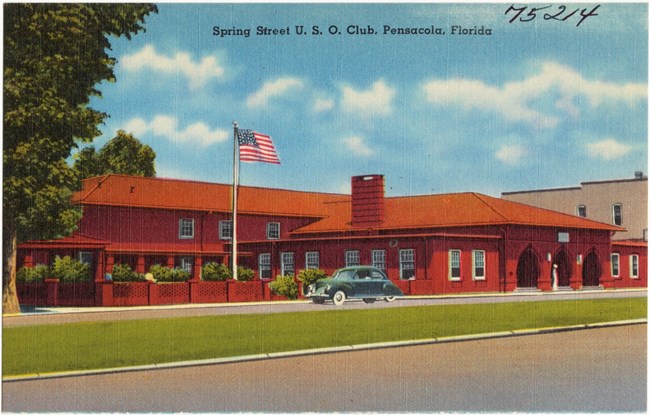
Credit Boston Public Library
About this Lesson
This lesson is part of a series teaching about the World War II home front, with Pensacola and Escambia County designated as an American World War II Heritage City. The lesson contains photographs, a background reading, and newspaper excerpts to contribute to learners’ understandings about the experiences and contributions of community connections to the Armed Forces, such as through civilian volunteer efforts and recreation.
Objectives:
- Describe the purpose of the USO sites to the Pensacola and Escambia County community
- Identify ways that civilians and home front workers contributed to the USO
- Share examples of segregation and its impact on the home front during WWII
Materials for Students:
- Photos (can be displayed digitally)
- Readings 1, 2, 3 (three primary)
- Recommended: Map of Pensacola and Escambia County, Florida and/or, Downtown Pensacola (Example: 1944 Downtown Pensacola)
- Optional Extension materials
Getting Started: Essential Question
How did the USO engage with and support the service members and greater Pensacola and Escambia County community during wartime?
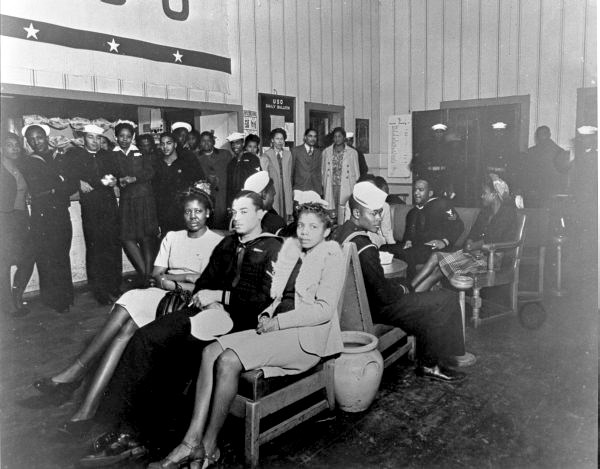
Credit: State Archives of Florida, Florida Memory
Key Vocabulary:
USO: The United Service Organizations, Inc. was founded in February 1941 as a joint charitable organization to serve active-duty service members at home and abroad. They operated clubs and facilities for service members and provided mobile entertainment and services.
By the numbers:
In each of the readings, you will notice many numbers and statistics. Find a few that are significant or interesting to you. What makes them meaningful? Why were they included by the authors?
Quotation to consider:
“In some overburdened communities where recreational facilities are inadequate and where the government requests it, USO makes its services available to war workers and women in industry. When you good people of Pensacola and Escambia County contribute to the Pensacola Community Chest and War Fund, remember that you are helping the USO as well as all the other worthy agencies.”
- Charles W. Smith, president of the Pensacola Community Chest and War Fund, in Pensacola News Journal, October 17, 1943 (p.22)
Read to Connect
Teacher Tips:
- Share the definition of USO- See Key Vocabulary if students haven't already.
- Have students highlight the different USO units described, or color code for each unit. The different unit names were bolded when first introduced in the article, for support.
- The Belmont Street club written about in Reading 1 was the USO club for African American service members. In 1943 this USO club was relocated to DeVilliers Street (See Reading 2).
USO is Combination of Six Organizations Banded to Aid Service Men in Recreations
Pensacola News Journal; Feb. 25, 1942, p. 20 - 21
United Service Organizations, Inc. Is a combination of six independent organizations, banded together to serve more effectively the men and women of the United States services and associated workers in the ‘all-out’ war effort.
These six are, the Jewish Welfare Board, the National Catholic Community service, the National Travelers Aid association, the Salvation army, the Young Men’s Christian association, and the Young Women’s Christian association.
Under this working combination, now familiarly known as the U.S.O., nearly 1,200 clubs and service operations have been opened staffed by over 1,900 workers. In its brief history of less than two years, the U.S.O. has demonstrated a high level of co-operation that is significant because it has been so comprehensive. Organizations and individuals of our three great faiths, Catholic, Jewish and Protestant, have been working wholeheartedly together, emphasizing the need for unified unqualified service, and minimizing the theological differences that have separated them.
The U.S.O. is working equally for men and women, and for both together. Furthermore, the traditional racial antipathies have not prevented these organizations from serving the colored service men and the colored defense workers, both men and women.
. . . Employed workers of the U.S.O. in Pensacola have increased from one in September 1941, to ten at the present time. . .Under the U.S.O. council there are at present five clubs in Pensacola, in each of which the following facilities are available for service men, wives and other associated in the war effort: social and meeting rooms, game rooms, libraries, auditoriums, victrolas, radios, pianos, room registries, checkrooms, information bureaus, and state registration lists. Using these facilities the clubs operate full programs of dances, game parties, movies, teas, clubs, classes, hobby groups, forums, dramatics, concerts and socials, in addition to special seasonal activities.
The La Rua Street USO club occupies the spacious old Brent home at the corner of Spring and La Rua streets and is operated by the national board of the Young Women’s Christian association of the United States. . .The untiring efforts of the director and the advisory board were devoted to securing suitable quarters for a club. Many disappointments and reverses were met until the Brent estate donated the use of their home to the U.S.O. for the duration.
This spacious old brick mansion with its paneled and tapestried walls and crystal chandeliers lends itself unusually well to the fulfillment of one of the basic U.S.O. policies of ‘a home away from home.’
The club is undergoing extensive repairs and already has completed attractive lounges, game rooms, library, and kitchen. When completed, the second floor will provide lounges and sleeping accommodations for 25 to 30 girls and women, being one of the few U.S.O. clubs offering housing facilities for women.
Attendance has doubled since the opening of the club for evenings the first of December, there being a total of 3,578 for the month.
One of the outstanding services of the La Rua Street U.S.O. is a room registry service for girls and women. Rooms are listed and recommended as suitable for wives, mothers and friends of Army and Navy personnel. During December, rooms were found for over 400 requests. Many individual emergency problems pertaining to Travelers’ Aid have been met with the aid of local case work agencies. . .Miss Eunice M. Hurd is the director of this club. . . .
The Spring Street U.S.O. club, occupying the Federal Community Recreation building, is operated by the Army-Navy Young Men’s Christian association.
The club affords the program facilities listed above, and in addition operates a snack bar, and has available a photo dark room, shower baths, outdoor pavilion and dance floor, and over-night cots. The club is open 24 hours every day.
Its program has been largely expanded by reason of the many volunteer groups who sponsor and participate in the various social activities. . . .
The U.S.O. club located at the corner of Palafox and Gregory streets is operated by the National Catholic Community Service. It was dedicated Jan. 31, 1942. . . . Women are organized according to parishes and are known as ladies of the month. They serve as chaperones, hostesses, and contributors of home-made refreshments.
A military maid organization was formed among the girls of the club. In addition to being dancing and social partners for the service men, they act as announcers for the club radio station, writers for the club weekly, ‘On the Beam,’ and hostesses at the door. . . . This U.S. O. club enjoys the special privilege of being one of two in the country offering radio programs direct to a naval air base.
Station PNAS has studios in the club and broadcasts exclusively to the Naval Air station from 5 to 6 p.m., and 8:45 to 10 p.m. daily. Equipment for recording letters home is available. The club is also equipped with a soft drink bar. . . .
The Belmont Street U.S.O. club, 421-A West Belmont street, began operation July 10, 1942, as a joint Army and Navy YMCA and National Catholic Community Service unit. . .. Activities are conducted in the colored Elk’s Rest on Coyle and Wright Streets and Mt. Zion Baptist church, Jackson and Coyle streets. A special feature of the club is the Vesper Hour chorus.
St. Joseph U.S.O. club is operated by the National Catholic Community Service. . . .This U.S. O. club is located in the St. Joseph Parish house at 210 South Barcelona Street. The facilities consist of reading, writing and game room, open every evening from 7:30 to 10:30 for entertainment and on Sundays from 12 noon to 10:30 p.m. , for special services for the men from outlying posts.
The special service which this organization offers is the promotion of entertainment at Eglin Field. Girls registered with U.S.O. organizations are transported to Eglin two or three times each month to help entertain the men. This service is highly appreciated by the men and enjoyed by the volunteer workers. Transportaion is furnished by Army buses. . ..
The Jewish Welfare board organized a unit in Pensacola last October. I. A. Siegel, formerly stationed in the Camp Wheeler area in Georgia, was designated as director. The agency has temporary quarters at the U.S.O. club, 200 West La Rua.
The board is conducting weekly socials at the ‘Barn,’ 101 West Jackson Street, and is co-operating with chaplains in providing adequate religious services for Jewish service men in nearby bases.
Morris Levy, Army and Navy JWB chairman, has held that position in Pensacola for the past 25 years. During World War 1, he organized the first JWB committee in Pensacola.
Background: African American service members faced segregation and discrimination. The military and its facilities in Florida were segregated. USO clubs were also segregated. USO activities listed in the Pensacola News Journal were categorized under “USO Negro Division” or labeled with “(Negro)” to label activities as for African American or white service members. This historical language is not appropriate and should not be used today. There were also segregated religious services.
The USO club for African American service members was first located on Belmont Street but was relocated in 1943 to North Devilliers Street in Pensacola. This USO club was very popular, with regularly increasing attendance. On October 6, 1944, the Pensacola Journal reported that this USO “expanded to a 24-hour service for colored Army and Navy personnel and had made a request for additional professional help which is to be forwarded to the regional USO office at Atlanta” (p.3).
Newspaper article
DeVilliers USO Club is Active
Negro Service Men Get Entertainment
Pensacola News Journal, February 11, 1944, p.7
With a dance last Saturday night, the DeVilliers Street USO club opened its two-day celebration of national open house commemorating the third anniversary of the USO’s and closed it Sunday night with coffee hour.
Saturday night approximately 450 service men and women attended the dance. Eunice Thompson, assistant director, and her committee had the large spacious social hall decorated.
The 727th U.S. Army Band of Eglin Field gave a band concert Sunday. Approximately 175 persons sat through this program. . .
The DeVilliers Street club, serving Eglin Field, Naval Air Station and auxiliary fields is one of the largest clubs for Negro service men in Florida. During 1943 two hundred fourteen volunteers gave a total of 7782 hours as information aides, clerks, snack bar attendants, cloakroom attendants, housing aides, church partners, game partners, dance partners, chaperones, and serving on committees. The senior and junior hostesses committees had a yearly attendance of 1449. The religious programs brought out 1724 servicemen and civilians. Approximately 4250 attending the dances in the club, Elks Rest, Eglin Field, Naval Air Station and auxiliary fields. One thousand and seventy-seven servicemen were given lodging in private residences through the club group. Eighty-six service wives were found places to live while visiting their husbands. The club attendance grew from 585 in January 1943 at the Belmont Street location to 7, 700 in December 1943 in the new quarters making a total yearly attendance of 38,814 by count who visited the club.
Teacher Tip: In Reading 1, written in February 1942, Miss Eunice Hurd is listed as the director of the La Rua Street U.S.O. Over two years later, in this article, written in October 1944, she is listed as the executive secretary of the Pensacola U.S.O. council.
USO Provides Touch of Home to Veterans
By: Carl Liddle. Pensacola News Journal, Oct 8, 1944, p.5
When Pensacolans give to the war and community chest fund, they often ask: ‘Where does my money go?’
The question was answered Saturday by Miss Eunice M. Hurd, executive secretary of the Pensacola USO council, who explained that in a breakdown of Pensacola’s community chest and war fund quota, prepared by the local community chest, the various agencies have been classified in three distinctive groups; the Military front, the United Nations front and the Home front. As an outstanding member of the first group, the USO is included with the United Seamen’s service and War Prisoner’s aid.
Today the USO has close to 3,000 operating units, Miss Hurd said, servicing the fighting forces all over the western hemisphere. . .
In the Pensacola area, since Pearl Harbor, the four local USO clubs have entertained over 657,000 men and women at dances, while 148,113 have participated in social activities other than dances. Counseling and advice have been given to 21,975 of the armed forces or their families. For those letters to loved ones at home, 815,688 envelopes and postcards have been provided; the numbers of sheets of stationery for those envelopes can hardly be estimated. Housing for members of the armed forces, their families or war production workers has been secured for 69, 106 men, women and children, ranging in age from newly born five to six day old babies to young Johnnie Doughboy’s grandpop of 80 summers. No small part of this housing program has been carried on under the roofs of the Spring Street USO for service men and the La Rua Street USO for mothers, wives, children and sweethearts as well as WAVES and WACS.
Personal Services
Such personal services as mending, shaving, equipment, checking services, showers, laundry privileges and cooking facilities have been provided for 215, 735 individuals. Other services such as the snack bar, library facilities and just a quiet corner to sit or a meeting spot for friends has been made available to 3,952,477. The Pensacola USO’s have rendered 24 hour service to men and their families for the past 1,300 days.
‘The United Service organization could not have accomplished its great task without the aid of millions of friends,’ Miss Hurd concluded. ‘They range from children to adults in every American community, in the United States territories and possessions, and neighbor nations in this hemisphere, wherever USO operates its clubs and other services. Pensacola’s nickels and dollars will help in no small part in perhaps bringing an hour’s relaxation or maybe some sorely needed service to those who are really ‘taking the bumps.’ And it may help to bring a bit of comfort to the families left at home.’
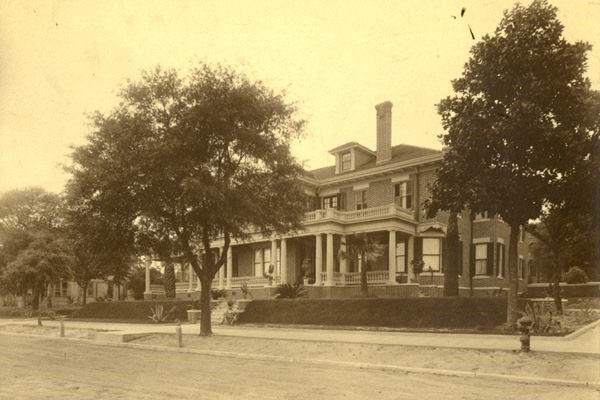
Credit: Photograph collection of Frances Brent Fick; located on Pensapedia
Student Activities
Questions for Reading 1 and Photos 1-3
- What were the main USO sites in Pensacola? Who did they serve?
- What were some of the differences among the USO sites?
- Describe unique details about 1) the La Rua Street USO club, in how it served women, and 2) the radio connections to the U.S.O. club located at the corner of Palafox and Gregory streets.
- How do you think volunteers were important to the success of USO provided services?
Questions for Reading 2
- What was the significance of the two-day celebration?
- What were some of the volunteer opportunities available at the DeVilliers Street USO club?
- Explain the significance of the DeVilliers Street USO club to the African American service members and civilians in the area.
- How did segregated USOs show the discrimination and racism that was happening in the United States during World War II?
Questions for Reading 3
- What services did the USO provide in Pensacola and Escambia County? How did civilians contribute or engage?
- Analyze the data to draw conclusions about the impact of the USO on the Pensacola and Escambia County community.
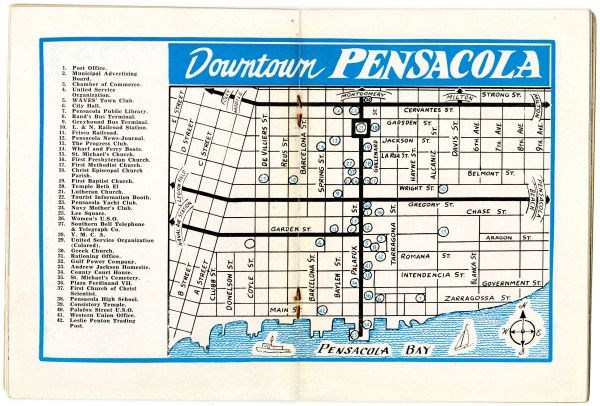
State Archives of Florida, Florida Memory.
Map Activities: USO sites on Downtown Pensacola, 1944
Using Readings 1-3 in the lesson, identify the USOs on the map of Downtown Pensacola. Highlight each one. There are four marked on the map. If helpful, access a bigger version of the map.
Guiding Questions to discuss as class, or small group:
-
What do you notice about the locations of the USOs?
-
What do you know about each of these sites, based on your readings?
- If you were to design historical markers for each of these sites, what details would you include for each?
Wrap Up: Connect back to the essential question
How did the USO engage with and support the service members and greater Pensacola and Escambia County community during wartime?
Extension Activities
Background: The Spring Street USO had distinctive arches and was one of the first USOs built in the United States by the WPA. The building was decommissioned in December 2019, and was demolished to be replaced by residential and retail development. Prior to the decision, local preservationists worked to try to save the building. Read the excerpt from the newspaper article, and then answer the reflection questions.
Preservationists hope to save USO building
By Anne Thrower. Pensacola News Journal, July 24, 2007, p. 13;
It was one of five permanent United Service Organizations buildings that then-first lady Eleanor Roosevelt urged Congress to fund during World War 2. Today it has become a downtown Pensacola eyesore because of damage from 2004’s Hurricane Ivan and is in danger of being razed.
The city has told the building’s current owner, the Escambia County School District, that something needs to be done.
The building sits at the edge of the future Vince Whibbs Community Maritime Park at 25 S. Spring St. Between Romana and Garden streets, adjacent to the School District’s Garden Street office.
The School District doesn’t necessarily want to tear the building down, said Shawn Dennis, assistant superintendent of operations. But that is one option, he said.
The Federal Emergency Management Agency has determined that it would cost about $1.8 million to refurbish the building as a warehouse, for which the School District has no use at that location, Dennis said.
Since the district took ownership of the property in October 2003, the building has been unused.
School officials have been working with state historical preservation officials for more than a year to determine what to do with the property.
‘It would be a nice building to save and maintain,’ said Dean DeBolt, vice president of the Pensacola Historic Preservation Society.
However, the local preservation group doesn’t have the money to repair the building.
Thousands of people used the USO facility during its heyday, DeBolt said. The $91,000 building opened in 1942.
Some 12,000 pilots trained in Pensacola in one year during the war. There were at least 100,000 additional support personnel in the area during the war years. Many would have visited the center, DeBolt said.
Reflection Questions
-
What was the historical significance of the Spring Street USO building?
-
What challenges did the school district face with the building, especially after Hurricane Ivan?
Although it is too late to preserve this building (it was demolished), think about other historically significant buildings, such as others you have learned about in Pensacola home front history. Also consider historically significant buildings in your community.
- What are some of the benefits of preserving historical buildings for your community?
Additional Resources
Jim Little. "It's not the Building its the People." Pensacola News Journal, December 2019.
"Seven to Save: Our 2019 List of Pensacola's Most At-Risk Sites." John Sunday Society.
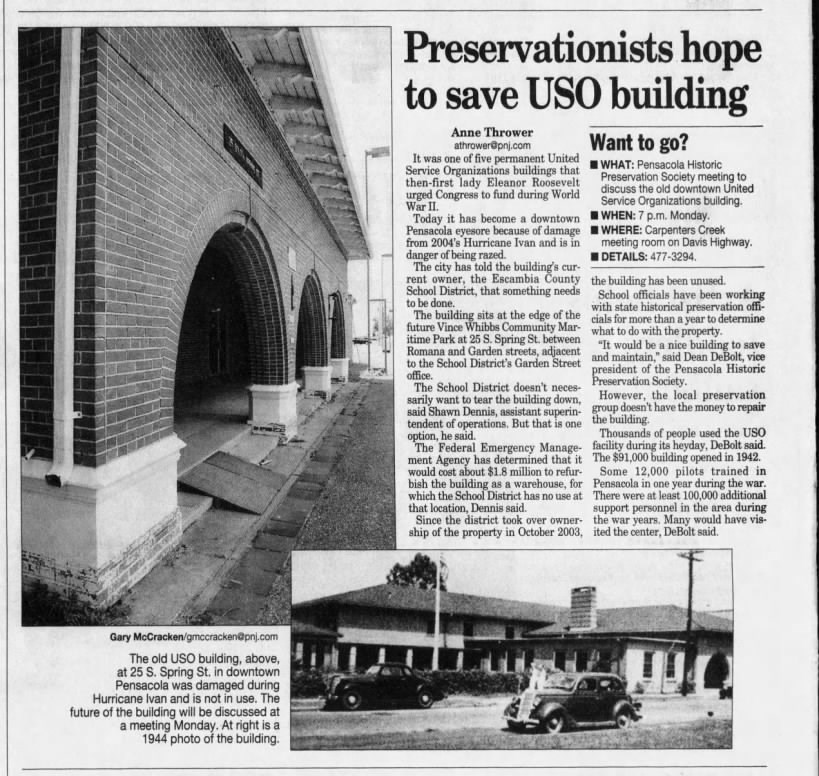
This lesson was written by Sarah Nestor Lane, an educator and consultant with the Cultural Resources Office of Interpretation and Education, funded by the National Council on Public History's cooperative agreement with the National Park Service.
Tags
- world war ii
- world war 2
- wwii
- ww2
- world war ii home front
- wwii home front
- american world war ii heritage city program
- awwiihc
- pensacola
- escambia county
- florida
- naval air station pensacola
- teaching with historic places
- twhp
- twhplp
- hour history lessons
- military and wartime history
- african americans in wwii
- wwii aah
- women's history
- women in world war ii
- jewish history
- volunteerism
- civic engagement
- uso
Last updated: July 3, 2024
